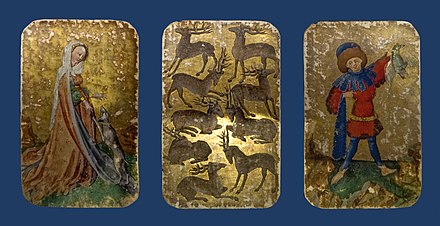Stuttgart card game

The so-called Stuttgart card game is one of the most valuable holdings in the Landesmuseum Württemberg . His leaves, painted on a gold background , were created around 1430 as a commissioned work by Wittelsbach in south-west Germany. It is the world's oldest surviving card game, consisting of 49 of the original 52 cards measuring 19 × 12 cm, and shows the four colors of duck, falcon or sparrowhawk , dog and deer. It is a pure four-color game, separated into women (deer, dog) and men (duck, falcon or sparrowhawk) cards.
History of the Stuttgart game
The card game was created between 1427 and 1431 and was first listed in the directory of the Kunstkammer of the Bavarian Dukes by Johann Baptist Fickler from 1598. Only guesses can be made about its place of origin.
In 1958, Gerhard Piccard was able to identify not only a temporal, but also a regional allocation in the Swabian region to Nuremberg , Augsburg and Zurich through the proof of watermarks from a Ravensburger paper mill . Playing card researchers associate the splendidly painted game with artists who illustrated books or made altarpieces. B. with the environment of the painting school Konrad Witz in Basel . But none of the many attempts at mapping has really succeeded so far.
In contrast to the place where it originated, its possessions can be fully documented: According to Guth's inventory, it should have belonged to Count von Helfenstein from 1642 onwards . The Guth collection was created by the Württemberg councilor and chamber master Johann Jakob Guth von Sulz in Durchhausen (1543-1616) and is said to have been so famous that it was visited by electors, princes and even imperial legates. The game with the Guth collection came into the possession of the Dukes of Württemberg in 1653 as a bequest from Ludwig Guth von Sulz, who thereby fulfilled his father's last will. With the Stuttgart Kunstkammer, the card game came into state ownership in 1927.
description
The individual cards are made of cardboard that is glued together from up to six layers of paper. The backs are uniformly painted red with red lead , were mixed in the little vermilion parts. The pictures on the front all have a gold background. The box was covered with chalk ground for production. The outline drawings of the figures and landscapes were scratched on it. Red bolus was applied as a base for the gilding . For the gilding itself, so-called intermediate gold was used to save gold instead of gold leaf .
The card game is recorded in the Fickler inventory of the ducal-Bavarian art chamber as follows:
- A fueteral in the form of a book covered with black leather, printed on it and gilded, so also on the cut, lined with red carmine, inside there is a large khartenspil of old franckian paintings on a gilded ground, instead of the bells, leaves, heart and acorn his dog, birds, deer and sparber painted, the cards are long and half-drawn.
With Fleischhauer it is assumed that this is the same card game that - without the case - is listed in Guth's collection inventory:
- A nice, big, very old card game with pretty pictures of old costumes, including animals, birds and bluomes, is said to have been the Count of Helfenstein many years ago.
Signs of wear and tear on the cards suggest that they are being used extensively, but due to their unwieldy format they were replaced by more suitable playing cards as early as the 16th century and, because of their valuable design, were kept in aristocratic art collections. Individual maps were published in large tables at the beginning of the 20th century.
The card game is exhibited in the art chamber of the Landesmuseum Württemberg .
literature
- Max Geisberg : Old playing cards . Körner, Baden-Baden 1973, ISBN 3-87320-205-0 (reprint of the edition Das Kartenspiel of the State and Antiquities Collection (State Museum) in Stuttgart: (1427/1431) . Strasbourg 1910 ( Studies on German Art History. Volume 132 )).
- Werner Fleischhauer : The history of the art chamber of the dukes of Württemberg in Stuttgart (= publications of the commission for historical regional studies in Baden-Württemberg. Volume 87). Württembergisches Landesmuseum, Stuttgart 1976.
- Werner Fleischhauer (arr.): Kunstkammer and Crown Jewels. Württembergisches Landesmuseum, Stuttgart 1977.
- Heribert Meurer, Irene Schuldt: The Stuttgart card game. 2nd Edition. Theiss, Stuttgart 1991, ISBN 3-8062-1009-8 .
- Württembergisches Landesmuseum Stuttgart: Art in the Old Castle. Theiss, Stuttgart 1998, ISBN 3-8062-1198-1 .
- Ulrike Wörner: The Stuttgart game (around 1429) - an image of the hunt for love. Iconological considerations on a card game by Wittelsbach. In: Bavarian Yearbook for Folklore. 2011, ISSN 0067-4729 , pp. 27-39.
- Katharina Küster-Heise: True Treasures Kunstkammer . Landesmuseum Württemberg, Stuttgart 2016, ISBN 978-3-7995-1142-1 .